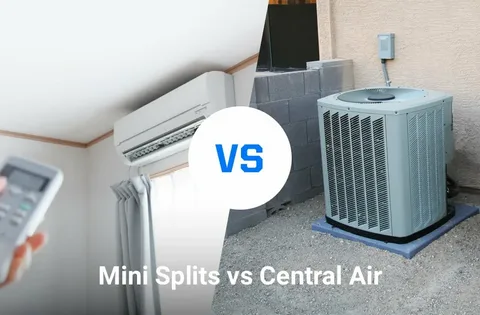Mini-Split vs. Central AC: Which Cooling System Is Right for You?

Choosing the right cooling system can make all the difference in your home’s comfort, energy bills, and long-term maintenance costs. For many Canadian homeowners, the decision often comes down to two main options: mini-split ductless systems and central air conditioners. While both can keep your home cool during the summer, they work in different ways and come with unique benefits. Understanding the strengths and limitations of each will help you make the best investment for your home.
How Central AC Works
A central AC system uses ductwork to distribute cool air throughout the entire home. One outdoor unit is connected to an indoor air handler, and cool air is pushed through ducts into each room. Central AC is often a preferred choice in homes that already have ductwork in place, such as those with existing furnaces. It delivers even cooling across multiple rooms at once, making it ideal for larger homes.
Learn more about system options in our central air conditioners section.
How Mini-Split Systems Work
A ductless mini-split system is made up of one outdoor compressor and one or more indoor units mounted directly in the rooms you want to cool. Instead of using ducts, each indoor unit delivers air straight into its space.
Mini-splits are especially effective for:
- Homes without existing ductwork
- Add-on rooms or finished basements
- Apartments, condos, or smaller living spaces
- Families with different comfort needs in different rooms
Comparing Energy Efficiency
Mini-splits are often more energy efficient because they eliminate the losses that happen in ductwork. In fact, leaky or poorly insulated ducts can waste up to 30% of a home’s cooling energy. By cooling only the rooms you use most, ductless systems save even more on utility bills. Central AC systems can also be efficient, especially when paired with proper insulation and a high SEER rating.
Check out more tips on saving money with how to lower AC costs in summer.
Cost Considerations
Upfront costs are usually lower for central AC if ductwork is already in place. However, adding ductwork to a home that doesn’t have it can be expensive.
Mini-splits may have higher installation costs per unit, but they avoid ductwork expenses altogether and provide savings on monthly energy bills. Long-term costs should also be considered. A central system might seem cheaper initially, but if ducts are leaky or need upgrading, the overall expense can rise quickly. Mini-splits offer lower energy bills each month, which over time helps balance out the higher upfront price.
Comfort and Zoning
One of the biggest advantages of ductless systems is zoned comfort. Each indoor unit has its own thermostat, so you can keep bedrooms cooler at night and living areas warmer during the day without over-cooling the whole house.
Central AC, on the other hand, cools the entire home at once, which is more convenient for families who prefer even temperatures everywhere.
For households with members who have different comfort preferences, mini-splits are often a game-changer. Parents can keep the living room comfortable while children sleep in cooler bedrooms, all without fighting over one thermostat setting.
Noise and Space
Mini-splits are designed for quiet operation. Indoor units typically produce less noise than window ACs or older central systems, making them ideal for bedrooms and home offices.
Central AC systems have most of their noise confined to the outdoor condenser, but air movement through ducts can sometimes be louder than a ductless system.
Space is another factor. Mini-splits take up little room indoors and don’t block windows like portable or window units. Central AC systems require space for ductwork, which isn’t always practical in smaller homes or older buildings.
Maintenance and Longevity
Both systems require regular maintenance to perform well.
For central AC, this includes cleaning ducts, replacing filters, and scheduling seasonal tune-ups.
For mini-splits, maintenance is simple, mainly cleaning filters and ensuring the outdoor unit is free of debris.
With proper care, central AC systems can last 12–15 years, while ductless mini-splits often last 15–20 years. The key difference is ductwork: if ducts are dirty, clogged, or leaking, central systems lose efficiency quickly. Mini-splits avoid this issue entirely.
Environmental Impact
Energy use doesn’t just affect your bills, it also impacts the environment. Mini-splits tend to be the greener choice since they minimize wasted energy by cooling only the rooms in use. Many models also use advanced refrigerants with lower environmental impact.
Central AC can still be eco-friendly if combined with high-efficiency units and well-sealed ductwork, but it generally consumes more energy overall compared to zoned ductless systems.
Aesthetic Considerations
Homeowners sometimes worry about how mini-split units will look on their walls. While they are visible, modern designs are sleek and unobtrusive. Many people find them less disruptive than bulky window units.
Central AC, by comparison, is nearly invisible indoors, since it uses vents built into walls or ceilings. For those prioritizing a traditional aesthetic, central systems may have the edge.
Which System Is Right for You?
Choosing between a mini-split and central AC comes down to your home’s layout, whether ductwork is available, your budget, and your comfort preferences.
- Central AC is best for larger homes with ductwork already in place and families who want even cooling throughout the house
- Mini-splits are ideal for smaller spaces, homes without ducts, or households that want personalized zoning and lower monthly bills
